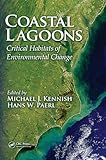Coastal lagoons: critical habitats of environmental change / edited by Michael J. Kennish, Hans W. Paerl
Kennish, Michael J [editor] | Paerl, Hans W [editor].
Tipo de material: Libro
impreso(a)
Series Editor: Boca Raton, Florida: CRC Press, 2010Descripción: 558 páginas : fotografías, ilustraciones, mapas ; 26 centímetros.ISBN: 9781420088304.Tema(s): Lagunas costeras
Libro
impreso(a)
Series Editor: Boca Raton, Florida: CRC Press, 2010Descripción: 558 páginas : fotografías, ilustraciones, mapas ; 26 centímetros.ISBN: 9781420088304.Tema(s): Lagunas costeras| Tipo de ítem | Biblioteca actual | Colección | Signatura | Estado | Fecha de vencimiento | Código de barras |
|---|---|---|---|---|---|---|
| Libros |
Biblioteca Chetumal
Texto en configuración de biblioteca Chetumal |
Acervo General | 551.4609 C6 | Disponible | ECO030007978 |
Incluye bibliografía e índice
Origins and fate of inorganic nitrogen from land to coastal ocean on the Yucatan Peninsula, Mexico T. Mutchler, R. F. Mooney, S. Wallace, K. H. Dunton, L. Podsim, and S. Fredriksen páginas 283-306 Subtropical karstic coastal lagoon assessment, SE Mexico: The Yucatan Peninsula case J. A. Herrera Silveira and S. M. Morales Ojeda páginas 307-333
Preface.. The Editors.. Contributors.. Chapter 1 Coastal Lagoons: Critical Habitats of Environmental Change.. Chapter 2 Assessing the Response of the Pamlico Sound, North Carolina, USA to Human and Climatic Disturbances: Management Implications.. Chapter 3 Sources and Fates of Nitrogen in Virginia Coastal Bays.. Chapter 4 Ecosystem Health Indexed through Networks of Nitrogen Cycling.. Chapter 5 Blooms in Lagoons: Different from Those of River-Dominated Estuaries.. Chapter 6 Relationship between Macroinfaunal Diversity and Community Stability, and a Disturbance Caused by a Persistent Brown Tide Bloom in Laguna Madre, Texas.. Chapter 7 The Choptank Basin in Transition: Intensifying Agriculture, Slow Urbanization, and Estuarine Eutrophication.. Chapter 8 Seagrass Decline in New Jersey Coastal Lagoons: A Response to Increasing Eutrophication.. Chapter 9 Controls Acting on Benthic Macrophyte Communities in a Temperate and a Tropical Estuary.. Chapter 10 Phase Shifts, Alternative Stable States, and the Status of Southern California Lagoons
Chapter 11 Lagoons of the Nile Delta.. Chapter 12 Origins and Fate of Inorganic Nitrogen from Land to Coastal Ocean on the Yucatan Peninsula, Mexico.. Chapter 13 Subtropical Karstic Coastal Lagoon Assessment, SE Mexico: The Yucatan Peninsula Case.. Chapter 14 Seasonal and Interannual Variability of Planktonic Microbes in a Mesotidal Coastal Lagoon (Ria Formosa, SE Portugal: Impact of Climatic Changes and Local Human Influences.. Chapter 15 A Comparison of Eutrophication Processes in Three Chinese Subtropical Semienclosed Embayments with Different Buffering Capacities.. Chapter 16 The Wadden Sea: A Coastal Ecosystem under Continuous Change.. Chapter 17 The Patos Lagoon Estuary: Biotic Responses to Natural and Anthropogenic Impacts in the Last Decades: páginas 979-2008.. Chapter 18 Structure and Function of Warm Temperate East Australian Coastal Lagoons: Implications for Natural and Anthropogenic Changes.. Chapter 19 Response of Venice Lagoon Ecosystem to Natural and Anthropogenic Pressures over the Last 50 Years.. Chapter 20 Effect of Freshwater Inflow on Nutrient Loading and Macrobenthos Secondary Production in Texas Lagoons.. Index
Dynamic and productive ecosystems, coastal lagoons play an important role in local economies and often bear the brunt of coastal development, agricultural, and urban waste, overuse from fisheries, aquaculture, transportation, energy production, and other human activities. The features that make coastal lagoons vital ecosystems underline the importance of sound management strategies for long-term environmental and resource sustainability. Written by an internationally renowned group of contributors, Coastal Lagoons: Critical Habitats of Environmental Change examines the function and structure of coastal lagoonal ecosystems and the natural and anthropogenic drivers of change that affect them. The contributors examine the susceptibility of coastal lagoons to eutrophication, the indicators of eutrophic conditions, the influences of natural factors such as major storms, droughts and other climate effects, and the resulting biotic and ecosystem impairments that have developed worldwide. They provide detailed descriptions of the physical-chemical and biotic characteristics of diverse coastal lagoonal ecosystems, and address the environmental factors, forcing features, and stressors affecting hydrologic, biogeochemical, and trophic properties of these important water bodies. They also discuss the innovative tools and approaches used for assessing ecological change in the context of anthropogenically- and climatically-mediated factors. The book investigates the biogeochemical and ecological responses to nutrient enrichment and other pollutants in lagoonal estuaries and compares them to those in other estuarine types. eng
